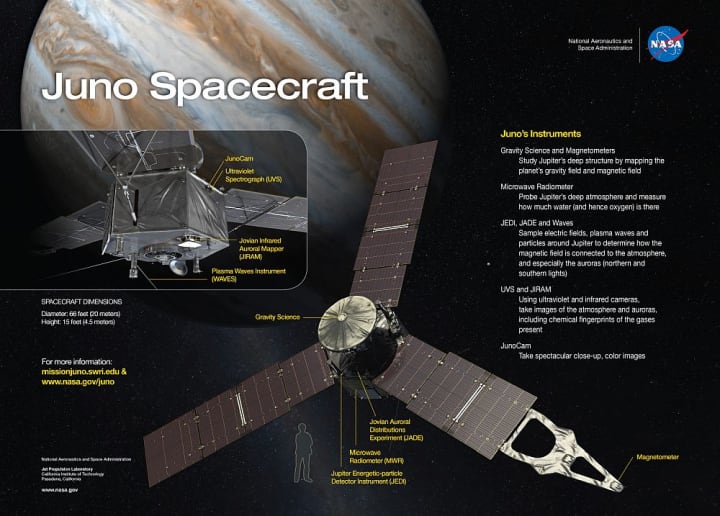Juno Spacecraft Makes Waves at Jupiter for Extended Mission
The Juno spacecraft orbiting Jupiter - now on an extended mission - finds radio waves coming from Ganymede - what is it?

The Juno spacecraft, orbiting Jupiter since 2016, has a new lease on life, thanks to NASA. This robotic explorer is now due to continue its mission, at least until September 2025.
A mission extension recently granted by NASA extends the Juno program means the spacecraft will continue to gather science about the largest planet in our Solar System and its retinue of dozens of moons. Some of these moons are known to have water (particularly Europa), and they may be among the most-likely places in the Solar System where we might find primitive life.
"Since its first orbit in 2016, Juno has delivered one revelation after another about the inner workings of this massive gas giant. With the extended mission, we will answer fundamental questions that arose during Juno's prime mission while reaching beyond the planet to explore Jupiter's ring system and Galilean satellites," Scott Bolton of the Southwest Research Institute, states.
Juno What?

The Juno spacecraft, first proposed in 2003, launched to Jupiter in 2011. Its primary mission, to explore how Jupiter formed and developed over time, was set to complete in July 2021.
This extended mission includes 42 additional orbits of Jupiter, including flybys of its moons Ganymede, Io, and Europa. Observations will also be taken of polar cyclones at the poles of Jupiter, and NASA will undertake the first-ever detailed study of the faint ring system encircling the planet.

Not only will these flybys provide amazing views and data concerning the moons of this mighty world, but these close encounters will also result in a shorter orbit, increasing the number of orbits Juno is able to complete.
Although, I Would TOTALLY Listen to that Station…

"Billy is face to face with outer space… Messages from distant stars… The local police calling all cars, radio waves… Hear them radio waves, radio waves…" - Radio Waves, Roger Waters
Juno also recently detected FM radio waves coming from one of Jupiter's largest moons, Ganymede. The waves were detected in magnetic lines connecting Ganymede to the polar regions of Jupiter.
However, this is not likely to be the result of an extraterrestrial Wolfman Jack broadcasting out the biggest hits of Jupiter.
"It's not E.T. It's more of a natural function," NASA spokesperson Patrick Wiggens tells KTVX in Utah.
See what Juno would look like, rotating in space. Video credit: The Cosmic Companion / Created in NASA's Eyes Visualization software.
Radio emissions around Jupiter, first detected in 1955, have been studied by researchers for decades.
The signal, seen for just five seconds as the spacecraft screamed past Ganymede at 180,000 KPH (nearly 112,000 MPH), was likely the result of electrons amplifying radio waves, in a process called cyclotron maser instability (CMI). This same effect, which likely resulted in the detection, can also generate ultraviolet auroras, also seen by Juno.
Over the coming years, Juno will provide ongoing data to researchers managing future missions to Jupiter, including NASA’s Europa Clipper and the JUpiter ICy moons Explorer (JUICE) mission from the European Space Agency.
---
James Maynard is the founder and publisher of The Cosmic Companion. He is a New England native turned desert rat in Tucson, where he lives with his lovely wife, Nicole, and Max the Cat.
Did you like this article? Join us on The Cosmic Companion Network for our podcast, weekly video series, informative newsletter, news briefings on Amazon Alexa and more!
About the Creator
The Cosmic Companion
The Cosmic Companion has been delivering high-quality, factual scientific news and features since 2018. We also offer a weekly show, Astronomy News with The Cosmic Companion, featuring interviews with scientists around the globe.






Comments
There are no comments for this story
Be the first to respond and start the conversation.